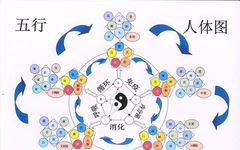1. The Five Directions and Five Elements:
East corresponds to Wood, South to Fire, West to Metal, North to Water, and Center to Earth. This is the essence of the He Tu, which states: “One and six correspond to North Water, two and seven to South Fire, three and eight to East Wood, four and nine to West Metal, and five to Center Earth.” This forms the foundation of the Five Elements.
Source: Chinese Feng Shui Research Association
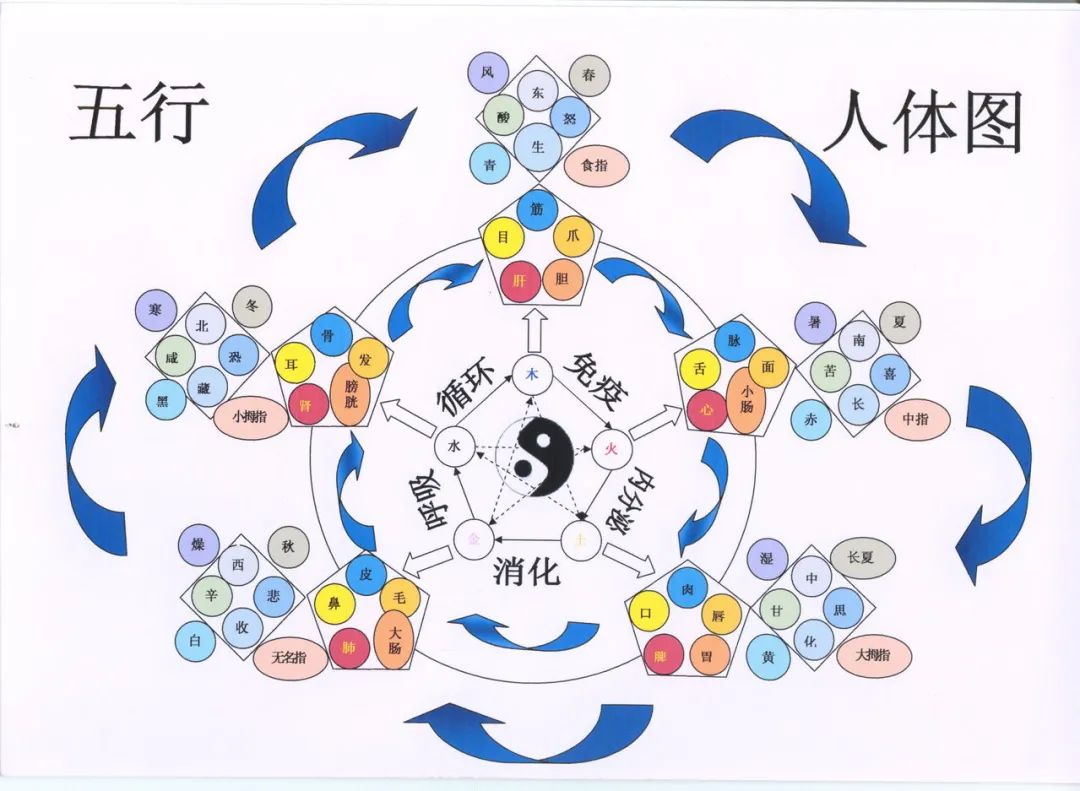
2. The Correct Five Elements:
This section discusses the eight mountains and twenty-four characters. The Zhen palace (震) corresponds to the characters Jia (甲), Yin (寅), and Yi (乙), which belong to Wood, with the adjacent palace being Yin (寅). The Li palace (离) corresponds to the characters Bing (丙), Wu (午), and Ding (丁), which belong to Fire, with the adjacent palace being Si (巳). The Dui palace (兑) corresponds to the characters Geng (庚), You (酉), and Xin (辛), which belong to Metal, with the adjacent palace being Shen (申). The Kan palace (坎) corresponds to the characters Ren (壬), Zi (子), and Gui (癸), which belong to Water, with the adjacent palace being Hai (亥). The Gen (艮) and Kun (坤) palaces correspond to the characters Chen (辰), Xu (戌), Chou (丑), and Wei (未), which belong to Earth. The Xun (巽) palace originally belongs to Wood, while the Qian (乾) palace originally belongs to Metal. This is the foundation of the Five Elements. People use divination, Feng Shui, and burial practices based on the Correct Five Elements, and when choosing a home, the Correct Five Elements are often the primary consideration.
3. The Three Harmonies of the Five Elements:
The Three Harmonies of the Five Elements refer to the twelve Earthly Branches that meet every four, forming a Three Harmony configuration. The twelve life stages are: Birth, Bathing, Crown, Official, Emperor’s Prosperity, Decline, Illness, Death, Grave, Extinction, Pregnancy, and Nourishment. These symbolize the cycle of life and death. For example, in the Five Elements, Fire’s Birth is in Yin (寅), its Prosperity is in Wu (午), and its Grave is in Xu (戌), thus forming a Fire configuration with Yin, Wu, and Xu. In the twelve Earthly Branches, they are paired every four, and in the twenty-four mountains, they are paired every eight, which is referred to as “Eight Generations of Life.” Therefore, Yin, Wu, and Xu belong to Fire, with Birth in Yin, Prosperity in Wu, and Grave in Xu; Hai, Yin, and Wei belong to Wood, with Birth in Hai, Prosperity in Yin, and Grave in Wei; Shen, Zi, and Chen belong to Water, with Birth in Shen, Prosperity in Zi, and Grave in Chen; Si, You, and Chou belong to Metal, with Birth in Si, Prosperity in You, and Grave in Chou. According to the Chinese Feng Shui Research Association, Yin, Shen, Si, and Hai are the positions of Birth, Zi, Wu, Yin, and You are the four Prosperity positions, and Chen, Xu, Chou, and Wei are the four Grave positions. The only element missing is Earth. The application of the Three Harmonies of the Five Elements is extensive, and the Three Harmony school of Feng Shui determines the auspiciousness of water based on this, while the Xuan Kong school often uses it in verification.
4. Double Mountain Five Elements:
This refers to the twelve characters of the eight mountains and twenty-four directions, which are categorized under the twelve Earthly Branches according to their Five Element attributes based on the Three Harmonies of the Five Elements. Since two characters belong to the same category, it is called Double Mountain Five Elements. For example, Ren (壬) belongs to Zi (子) and is Water, Gui (癸) belongs to Chou (丑) and is Metal, and so on. Thus, Yin, Wu, and Xu, as well as Gen, Bing, and Xin, all belong to Fire; Hai, Yin, and Wei belong to Wood; Shen, Zi, and Chen belong to Water; Si, You, and Chou belong to Metal. In the compass, the heavenly plate is placed according to this Five Element reasoning.
5. The Twenty-Eight Mansions and Five Elements:
The Seven Mansions of the Eastern Azure Dragon: Jiao (角), Kang (亢), Di (氐), Fang (房), Xin (心), Wei (尾), and Ji (箕); the Seven Mansions of the Northern Black Tortoise: Dou (斗), Niu (牛), Nu (女), Xu (虚), Wei (危), Shi (室), and Bi (壁); the Seven Mansions of the Western White Tiger: Kui (奎), Lou (娄), Wei (胃), Mao (昴), Bi (毕), Zhi (觜), and Shen (参); the Seven Mansions of the Southern Vermilion Bird: Jing (井), Gui (鬼), Liu (柳), Xing (星), Zhang (张), Yi (翼), and Zhen (轸). This is the Five Elements of the Twenty-Eight Mansions.
6. The Seven Stars and Four Residuals of the Five Elements:
The Seven Stars refer to the twenty-eight mansions grouped into four sets of seven, thus called the Seven Stars and Four Residuals. The groups are: “Jiao, Kang, Di, Fang, Xin, Wei, Ji” for the Eastern Azure Dragon; “Dou, Niu, Nu, Xu, Wei, Shi, Bi” for the Northern Black Tortoise; “Kui, Lou, Wei, Mao, Bi, Zhi, Shen” for the Western White Tiger; and “Jing, Gui, Liu, Xing, Zhang, Yi, Zhen” for the Southern Vermilion Bird. The twenty-eight mansions form shapes in the sky and shapes on the ground, corresponding to the twenty-four mountains as illustrated:
The first layer is the post-heaven Eight Trigrams, the second layer is the twenty-four mountains, and the third layer is the twenty-eight mansions.
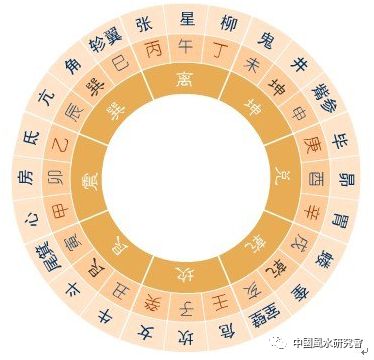
Diagram of the Eighteen Mansions placed on the Twenty-Four Mountains
The twenty-four mountains are arranged in a clockwise direction, while the twenty-eight mansions are arranged in a counterclockwise direction. Each of the four palaces of Yin, Shen, Si, and Hai contains two stars, while the other palaces contain one star. Once the positioning is established, the Five Elements of the twenty-four mountains are determined by the Five Elements of the twenty-eight mansions, with the saying: “Qian and Dui belong to Metal, Gen and Xun belong to Wood, Yin and Shen belong to Water, Jia and Geng belong to Fire, Zi and Wu belong to Fire, and Yi, Xin, Ding, and Gui harm the Earth, while Chen, Xu, Chou, and Wei belong to the Metal hall.” This is the Seven Stars and Four Residuals of the Five Elements, and the Three Harmonies of Feng Shui use these Five Elements according to the compass’s central needle to discern auspiciousness and inauspiciousness.
7. The Nine Stars and Five Elements:
The Nine Stars are: Tan Lang (贪狼), Ju Men (巨门), Lu Cun (禄存), Wen Qu (文曲), Lian Zhen (廉贞), Wu Qu (武曲), Po Jun (破军), Zuo Fu (左辅), and You Bi (右弼). These correspond to the Big Dipper’s seven stars plus the two stars Zuo Fu and You Bi, divided into Five Elements: Tan Lang is Wood, Ju Men and Lu Cun are Earth, Wen Qu is Water, Lian Zhen is Fire, Wu Qu is Metal, Po Jun is Metal, Zuo Fu is Earth, and You Bi is Metal. The Nine Stars help Feng Shui masters identify the shapes of the surrounding mountains in the Ming Tang (明堂) to discern auspiciousness and inauspiciousness.
8. The Five Elements of the Four Seasons:
In Spring, Wood is prosperous; in Summer, Fire is prosperous; in Autumn, Metal is prosperous; and in Winter, Water is prosperous. However, Earth is lacking, so at the end of each season, eighteen days are reserved for Earth, which is also known as the Day of Earth Prosperity. Each of the Five Elements takes seventy-two days, totaling three hundred sixty days. Therefore, the three days before the Grain Rain and the three days before the Beginning of Summer are the days of Spring Earth Prosperity; the three days before the Minor Heat and the three days before the Beginning of Autumn are the days of Summer Earth Prosperity; the three days before the Frost Descent and the three days before the Beginning of Winter are the days of Autumn Earth Prosperity; and the three days before the Major Cold and the three days before the Beginning of Spring are the days of Winter Earth Prosperity. It is not advisable to disturb the earth on Earth Prosperity Days. The Five Elements of the Four Seasons are particularly adhered to in divination and in the selection of auspicious days for Yin and Yang residences. This originates from the Correct Five Elements.
9. The Five Elements of the Na Yin:
The Na Yin of the Five Elements refers to the Na Yin of the sixty Jia Zi (甲子). According to the ten stems and twelve branches, they alternate to form sixty, which cycle continuously. For example, Jia Zi (甲子) and Yi Chou (乙丑) both belong to Metal, indicating the intention of marrying someone of the same position. Yi Chou (乙丑) Metal reaches Ren Shen (壬申), which is also Metal, indicating the intention of having a child from the eighth position. The specific content is:
Jia Zi (甲子) and Yi Chou (乙丑) are Metal in the sea; Bing Yin (丙寅) and Ding Mao (丁卯) are Fire in the furnace; Wu Chen (戊辰) and Ji Si (己巳) are Wood in the great forest; Geng Wu (庚午) and Xin Wei (辛未) are Earth by the roadside; Ren Shen (壬申) and Gui You (癸酉) are Metal at the sword’s edge; Jia Xu (甲戌) and Yi Hai (乙亥) are Fire on the mountain top; Bing Zi (丙子) and Ding Chou (丁丑) are Water in the stream; Wu Yin (戊寅) and Ji Mao (己卯) are Earth on the city wall; Geng Chen (庚辰) and Xin Si (辛巳) are White Wax Metal; Ren Wu (壬午) and Gui Wei (癸未) are Willow Wood; Jia Shen (甲申) and Yi You (乙酉) are Water in the well; Bing Xu (丙戌) and Ding Hai (丁亥) are Earth on the roof; Wu Zi (戊子) and Ji Chou (己丑) are Thunder Fire; Geng Yin (庚寅) and Xin Mao (辛卯) are Pine and Cypress Wood; Ren Chen (壬辰) and Gui Si (癸巳) are Long Flowing Water; Jia Wu (甲午) and Yi Wei (乙未) are Gold in the sand; Bing Shen (丙申) and Ding You (丁酉) are Fire under the mountain; Wu Xu (戊戌) and Ji Hai (己亥) are Earth in the flat land; Geng Zi (庚子) and Xin Chou (辛丑) are Earth on the wall; Ren Yin (壬寅) and Gui Mao (癸卯) are Gold in the foil; Jia Chen (甲辰) and Yi Si (乙巳) are Fire in the lamp; Bing Wu (丙午) and Ding Wei (丁未) are Water in the Milky Way; Wu Shen (戊申) and Ji You (己酉) are Earth in the great station; Geng Xu (庚戌) and Xin Hai (辛亥) are Gold in the hairpin; Ren Zi (壬子) and Gui Chou (癸丑) are Mulberry and Ziziphus Wood; Jia Yin (甲寅) and Yi Mao (乙卯) are Water in the great creek; Bing Chen (丙辰) and Ding Si (丁巳) are Earth in the sand; Wu Wu (戊午) and Ji Wei (己未) are Fire in the sky; Geng Shen (庚申) and Xin You (辛酉) are Pomegranate Wood; Ren Xu (壬戌) and Gui Hai (癸亥) are Water in the ocean.
In the pre-heaven diagram, Qian (乾) and Dui (兑) are the first and belong to Metal, followed by Li (离) which belongs to Fire, then Zhen (震) and Xun (巽) which belong to Wood, then Kan (坎) which belongs to Water, and finally Gen (艮) and Kun (坤) which belong to Earth. Thus, it starts with Metal and ends with Earth, which signifies the meaning of Qian beginning and Kun completing. Metal represents the strength of heaven, Earth represents the softness of the ground, Fire is attached to heaven, Water is attached to the earth, and Wood resides in the center with vitality.
In the post-heaven Eight Trigrams, Qian remains at the top but is reversed. Qian and Dui, both Metal, prosper in the West, reversed in Li, which prospers in the South, then reversed in Zhen and Xun, both Wood, which prosper in the East, and then reversed in Kan, which prospers in the North, while Earth prospers in all four seasons, thus retreating to Gen and Kun to conclude.
Attached are 20 Five Element Mnemonics
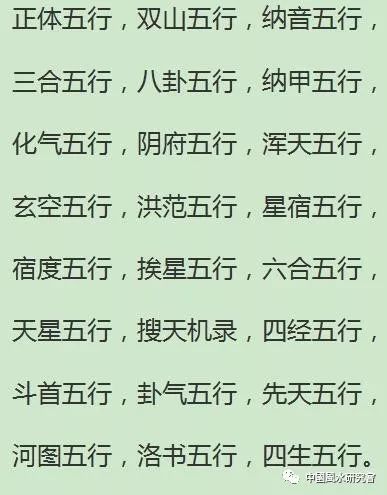
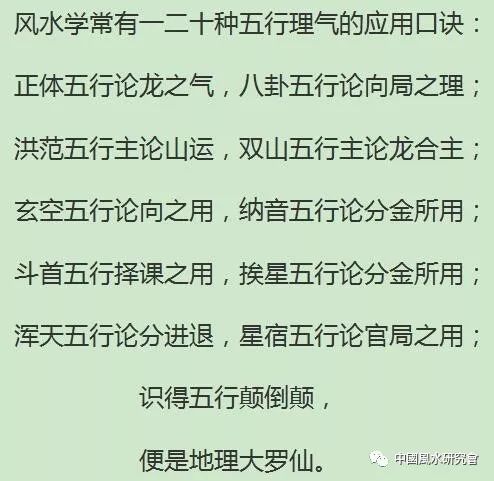
1. The Correct Body Five Elements:
Hai (亥), Ren (壬), Zi (子) belong to North Water; Yi (已), Bing (丙), Wu (午), and Ding (丁) belong to South Fire.
Yin (寅), Jia (甲), Yi (乙), and Mao (卯) belong to the Wood Palace; Geng (庚), Shen (申), and Xin (辛) belong to the Metal Palace.
Chen (辰), Xu (戌), Chou (丑), and Wei (未) belong to the Earth Palace. This is the ancestor of the Five Elements.
2. The Eight Trigrams and Five Elements:
Qian (乾) and Dui (兑) belong to Metal; Kun (坤) and Gen (艮) belong to Earth;
Kan (坎) belongs to Water; Li (离) belongs to Fire; Zhen (震) and Xun (巽) belong to Wood.
These Eight Trigrams and Five Elements are also the Correct Body Five Elements. Besides the Correct Body Five Elements, there are many other Five Elements.
The Correct Body Five Elements are the basic attributes of the Five Elements of the Heavenly Stems and Earthly Branches, and other Five Element attributes are derived from the Correct Body Five Elements.
3. The Na Jia Five Elements:
Qian (乾), Jia (甲), Dui (兑), Ding (丁), Si (丑) belong to Metal; Li (离), Ren (壬), Yin (寅), and Xu (戌) belong to Fire; Xun (巽), Xin (辛), Zhen (震), and Hai (未) belong to Wood; Kan (坎), Gui (癸), Shen (申), and Chen (辰) belong to Water; Gen (艮), Bing (丙), and Kun (坤) belong to Earth. The stems and branches follow the hexagrams as a family.
The mnemonic is based on the Correct Five Elements of the post-heaven hexagrams, assigning this Five Element attribute to the stems and branches. Here, Zhen represents Mao, and Dui represents You, while Zi uses Kan, and Wu uses Li, corresponding to the above Correct Body Five Elements mnemonic. In practice, Na Jia is used more frequently.
4. The Heavenly Stems Transforming Qi Five Elements:
Jia (甲) and Ji (己) transform into Earth; Yi (乙) and Geng (庚) transform into Metal;
Ding (丁) and Ren (壬) transform into Wood, coming from the forest;
Bing (丙) and Xin (辛) transform into Water, flowing away;
Wu (戊) and Gui (癸) transform into Fire, permeating.
This indicates that the ten stems combine in pairs to transform into a new Five Element. Searching for the public account of the Chinese Feng Shui Research Association, in destiny studies, the transformation of the Heavenly Stems must consider conditions. If the conditions are not met, even if both stems are present, they cannot transform, which is known as the phenomenon of “combining without transforming.”
Note: The Heavenly Stems Transforming Qi Five Elements is based on the discovery of the sages that the stars of the Big Dipper resemble dragons in the sky, while the mountains and rivers on the ground also resemble dragons, hence the origin of mountain dragons and water dragons.
The ancients regarded the Chen star as the dragon’s head and the Xu star as the dragon’s tail, using the Five Elements to imply this meaning, thus the theory of the pre-heaven ten stems transforming Qi was established. The reasoning is based on the Na Yin of the sixty Jia Zi.
For example, Jia and Ji start from Jia Zi and retreat to Chen, which is Wu Chen, and its Na Yin is Earth. Therefore, Jia and Ji transform into Earth, which is the basis for the theory of transformation from the dragon. This is the basis for the transformation of the Five Elements of the Heavenly Stems.
Jia and Ji transform into Earth; Yi and Geng transform into Metal; Bing and Xin transform into Water; Ding and Ren transform into Wood; Wu and Gui transform into Fire. The ten stems govern the operations of heaven and earth. Therefore, the Five Elements of the Heavenly Stems Transforming Qi are subject to the flow of Qi and change.
For example, in the year and month pillars, if the Heavenly Stems Ding and Ren combine, during the periods before Rain Water and Awakening of Insects, the Five Elements trend towards Wood, while during the periods before Grain Buds and Summer Solstice, Ding and Ren trend towards Fire. This tendency is not the essence of the ten Heavenly Stems.
However, in Feng Shui and date selection, it is not emphasized too much, and sometimes it does not consider whether both stems are complete.
For example, it is said that “the correct Yin house avoids both stems being complete, while the single Yin house does not avoid a single stem.” Below is the Five Elements of the Yin House.
5. The Five Elements of the Yin House:
Gen (艮), Bing (丙), and Xun (辛) belong to the Water region;
Qian (乾), Jia (甲), Li (离), Yin (寅), and Xu (戌) belong to the Earth region;
Dui (兑), Ding (丁), Si (丑), Qian (乾), and Ren (壬) belong to the Wood region;
Shen (申), Chen (辰), Kan (坎), and Gui (癸) belong to the Fire region;
Zhen (震), Geng (庚), Hai (亥), and Wei (未) belong to the Earth region, transforming into the Western Metal.
This is derived from the Heavenly Stems Transforming Qi Five Elements. The so-called Yin House refers to the Heavenly Stems Transforming Qi Five Elements overcoming the Eight Trigrams’ Na Jia Transforming Qi Five Elements.
Originally, the Earthly Branches, except for Zi (子), Wu (午), Mao (卯), and You (酉), did not participate in the Yin House, but some good-hearted individuals expanded the Yin House’s team, making the Earthly Branches also inescapable.
Thus, the theory of the Yin House does not emphasize the conditions for combining and transforming, and sometimes it does not care whether both stems are complete, so some people think it is too far-fetched.
6. The Three Harmonies of the Five Elements:
Hai (亥), Mao (卯), Wei (未), Qian (乾), Jia (甲), and Ding (丁) are all Tan Lang (贪狼) positions (belonging to Wood);
Yin (寅), Wu (午), Xu (戌), Gen (艮), Bing (丙), and Xin (辛) are all Lian Zhen (廉贞) positions (belonging to Fire);
Si (巳), You (酉), and Chou (丑), Xun (巽), Geng (庚), and Gui (癸) are all Wu Qu (武曲) positions (belonging to Metal);
Shen (申), Zi (子), and Chen (辰), Kun (坤), Ren (壬), and Yi (乙) are all Wen Qu (文曲) positions (belonging to Water);
This is a type of Five Elements that Yang Gong Feng Shui emphasizes, often used for orientation and date selection, and is quite effective.
7. The Earthly Branches Transforming Qi Five Elements:
Zi (子) and Chou (丑) combine to transform into Earth; Yin (寅) and Hai (亥) combine to transform into Wood; Mao (卯) and Xu (戌) combine to transform into Fire;
Chen (辰) and You (酉) combine to transform into Metal; Si (巳) and Shen (申) combine to transform into Water; Wu (午) and Wei (未) combine to transform into the Sun and Moon.
8. The Yin and Yang Five Elements:
Shen (申), Geng (庚), and Qian (乾) are Yang Metal born in Si (巳); Xin (辛), You (酉), and Yin (子) are Yin Metal born in Zi (子).
Ren (壬), Zi (子) are Yang Water born in Shen (申); Gui (癸), Hai (亥) are Yin Water born in Mao (卯).
Yin (寅), Jia (甲) are Yang Wood born in Hai (亥); Yi (乙), Mao (卯) are Yin Wood born in Hai (亥).
Searching for the public account of the Chinese Feng Shui Research Association.
Gen (艮), Chen (辰), and Xu (戌) are Yang Earth born in Shen (申); Chou (丑), Wei (未), and Kun (坤) are Yin Earth born in Mao (卯).
9. The Xuan Kong Five Elements:
Bing (丙), Ding (丁), and Yi (乙) belong to Fire; Qian (乾), Kun (坤), Mao (卯), and Wu (午) belong to Metal;
Hai (亥), Gui (癸), Jia (甲), and Gen (艮) belong to Wood; Xu (戌), Geng (庚), Chou (丑), and Wei (未) belong to Earth;
Zi (子), Yin (寅), Chen (辰), and Xun (巽) belong to Water; Xin (辛) and Ren (壬) belong to the Water God.
10. The Hunyuan Five Elements:
Li (离) Fire and Kan (坎) Water; Qian (乾) Metal and Dui (兑) class; Kun (坤) and Gen (艮) both belong to Earth;
Zhen (震) and Xun (巽) are both Wood; the Eight Directions bring auspiciousness, and one hexagram governs three mountains.
11. The Na Yin Five Elements:
Zi (子) and Wu (午) are Silver Lanterns hanging on the wall; Chen (辰) and Xu (戌) are smoke filling the temple bell tower. Yin (寅) and Shen (申) are sandy ground burning wet firewood, which is the Na Yin of the six Jia heads.
Jia Zi (甲子) and Yi Chou (乙丑) are Metal in the sea; Bing Yin (丙寅) and Ding Mao (丁卯) are Fire in the furnace; Wu Chen (戊辰) and Ji Si (己巳) are Wood in the great forest; Geng Wu (庚午) and Xin Wei (辛未) are Earth by the roadside; Ren Shen (壬申) and Gui You (癸酉) are Metal at the sword’s edge; Jia Xu (甲戌) and Yi Hai (乙亥) are Fire on the mountain top; Bing Zi (丙子) and Ding Chou (丁丑) are Water in the stream; Wu Yin (戊寅) and Ji Mao (己卯) are Earth on the city wall; Geng Chen (庚辰) and Xin Si (辛巳) are White Wax Metal; Ren Wu (壬午) and Gui Wei (癸未) are Willow Wood; Jia Shen (甲申) and Yi You (乙酉) are Water in the well; Bing Xu (丙戌) and Ding Hai (丁亥) are Earth on the roof; Wu Zi (戊子) and Ji Chou (己丑) are Thunder Fire; Geng Yin (庚寅) and Xin Mao (辛卯) are Pine and Cypress Wood; Ren Chen (壬辰) and Gui Si (癸巳) are Long Flowing Water; Jia Wu (甲午) and Yi Wei (乙未) are Gold in the sand; Bing Shen (丙申) and Ding You (丁酉) are Fire under the mountain; Wu Xu (戊戌) and Ji Hai (己亥) are Earth in the flat land; Geng Zi (庚子) and Xin Chou (辛丑) are Earth on the wall; Ren Yin (壬寅) and Gui Mao (癸卯) are Gold in the foil; Jia Chen (甲辰) and Yi Si (乙巳) are Fire in the lamp; Bing Wu (丙午) and Ding Wei (丁未) are Water in the Milky Way; Wu Shen (戊申) and Ji You (己酉) are Earth in the great station; Geng Xu (庚戌) and Xin Hai (辛亥) are Gold in the hairpin; Ren Zi (壬子) and Gui Chou (癸丑) are Mulberry and Ziziphus Wood; Jia Yin (甲寅) and Yi Mao (乙卯) are Water in the great creek; Bing Chen (丙辰) and Ding Si (丁巳) are Earth in the sand; Wu Wu (戊午) and Ji Wei (己未) are Fire in the sky; Geng Shen (庚申) and Xin You (辛酉) are Pomegranate Wood; Ren Xu (壬戌) and Gui Hai (癸亥) are Water in the ocean.
12. The Five Elements of the Twenty-Eight Mansions:
The Seven Mansions of the Eastern Azure Dragon: Jiao (角), Kang (亢), Di (氐), Fang (房), Xin (心), Wei (尾), and Ji (箕).
The Seven Mansions of the Northern Black Tortoise: Dou (斗), Niu (牛), Nu (女), Xu (虚), Wei (危), Shi (室), and Bi (壁).
The Seven Mansions of the Western White Tiger: Kui (奎), Lou (娄), Wei (胃), Mao (昴), Bi (毕), Zhi (觜), and Shen (参).
The Seven Mansions of the Southern Vermilion Bird: Jing (井), Gui (鬼), Liu (柳), Xing (星), Zhang (张), Yi (翼), and Zhen (轸).
13. The Five Elements of the Star Arrangement:
Qian (乾), Kun (坤), Gen (艮), and Xun (巽) belong to the Wood region; Yin (寅), Shen (申), Si (巳), and Hai (亥) belong to the Water region;
Jia (甲), Geng (庚), Bing (丙), and Ren (壬) originally belong to Fire; Zi (子), Wu (午), Mao (卯), and You (酉) are truly Fire; the Five Elements of Chen (辰), Xu (戌), Chou (丑), and Wei (未) belong to Metal, while Yi (乙), Xin (辛), Ding (丁), and Gui (癸) harm the Earth.
14. The Four Births of the Five Elements:
Gui (癸) and Chou (丑) belong to the Earth region; Yin (寅) and Hai (亥) belong to the Wood region; Mao (卯) and Xu (戌) belong to the Fire region;
Chen (辰) and You (酉) belong to the Metal region; Si (巳) and Shen (申) belong to the Water region; Wu (午) and Wei (未) belong to the Fire region.
15. The Dipper’s Head Five Elements:
Ren (壬), Zi (子), and Si (巳) belong to the Earth region; Gen (艮), Yin (寅), and Ding (丁) belong to the Wood region;
Gui (癸), Chou (丑), and Qian (乾) belong to the Fire region; Jia (甲), Mao (卯), and Kun (坤) belong to the Water region;
If you ask where the Metal Star is, it is at the four mountains of Yi (乙) and Geng (庚).
16. The Double Mountain Three Harmonies of the Five Elements:
Hai (亥), Mao (卯), Wei (未), Qian (乾), Jia (甲), and Ding (丁) are all Tan Lang (贪狼) positions (belonging to Wood);
Shen (申), Zi (子), and Chen (辰), Kun (坤), Ren (壬), and Yi (乙) are all Wen Qu (文曲) positions (belonging to Water);
Yin (寅), Wu (午), Xu (戌), Gen (艮), Bing (丙), and Xin (辛) are all Lian Zhen (廉贞) positions (belonging to Fire);
Si (巳), You (酉), and Chou (丑), Xun (巽), Geng (庚), and Gui (癸) are all Wu Qu (武曲) positions (belonging to Metal).
17. The Sand Removal Five Elements:
Qian (乾), Kun (坤), Gen (艮), and Xun (巽) belong to the Wood region; Yin (寅), Shen (申), Si (巳), and Hai (亥) belong to the Water region;
Zi (子), Wu (午), Mao (卯), and You (酉) truly belong to Fire; Jia (甲), Geng (庚), Bing (丙), and Ren (壬) are Fire dependent on the side;
Chen (辰), Xu (戌), Chou (丑), and Wei (未) belong to Metal, while Yi (乙), Ding (丁), Xin (辛), and Gui (癸) harm the Earth.
18. The Nine Stars and Five Elements:
The first white star, Tan Lang (贪狼), is the Water God; the second black star, Kun (坤), is the Earth that gives rise to Ju Men (巨门);
The third green star, Zhen (震), is Wood, and Lu Cun (禄存) is its relative; the fourth green star, Wen Qu (文曲), is Water, and Xun (巽) is its relative;
The fifth yellow star, Lian Zhen (廉贞), is the central Earth; the sixth white star, Wu Qu (武曲), belongs to Qian (乾) and is Metal;
The seventh red star, Po Jun (破军), is the Metal Palace of Dui (兑); the eighth white star, Gan (艮), is the Earth of Zuo Fu (左辅);
The ninth purple star, You Bi (右弼), is the Fire of Li (离); the nine palaces and eight trigrams are divided within.
19. The Generation of the Five Elements in the He Luo:
Heaven generates Water, and Earth completes it;
Earth generates Fire, and Heaven completes it;
Heaven generates Wood, and Earth completes it;
Earth generates Metal, and Heaven completes it;
Heaven generates Earth, and Earth completes it.
20. The Hong Fan Five Elements:
Jia (甲), Yin (寅), Chen (辰), and Xun (巽) belong to the great river; Xu (戌), Kan (坎), and Xin (申) belong to Water as well.
Gen (艮), Zhen (震), and Yi (已) belong to Wood; Wu (午), Ren (壬), Bing (丙), and Yi (乙) belong to Fire.
Dui (兑), Ding (丁), Qian (乾), and Hai (亥) belong to Metal; Chou (丑), Gui (癸), and Wei (未) belong to Earth.

